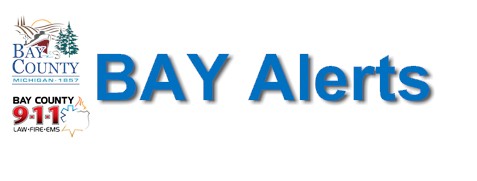Weather Warning Systems
Bay County's Outdoor Public Warning System
The Outdoor Public Warning System is intended to notify individuals, who patronize outdoor areas, of severe weather and other potential threats. (e.g.: Tornado Warning and Chemical Release) A steady siren wail signals that a warning has been issued. After hearing the siren, seek shelter and tune in to local television or radio for additional information. Currently, the Outdoor Public Warning System consists of nineteen sirens. Two sirens, located in Veterans Memorial Park, are digital and are capable of transmitting voice announcements as well as a siren wail. For more information go to the Outdoor Public Warning System webpage.

BAY Alerts and Smart911
BAY Alerts is Bay County's emergency mass notification system that will be used to contact County residents and businesses via phone messages, text messages and/or e-mail messages in case of emergency, like a tornado or severe thunderstorm warning. The system, called BAY Alerts, will be used by Bay County 9-1-1 to notify residents of emergencies or critical situations and provide information regarding necessary actions, such as evacuation and shelter-in-place. BAY Alerts is also a part of the Smart911 system, which can provide 911, and other first responders, important information when you call 911. Go to Smart911 or BAY Alerts to learn more and sign up.
NOAA Weather Radio All Hazards
NOAA Weather Radio All Hazards is a service provided by the National Weather Service (NWS). It provides continuous broadcasts of the latest weather information and forecasts from your local NWS office. NOAA Weather Radio All Hazards broadcasts important forecast and warning information as quick as possible.
With NOAA Weather Radio All Hazards, you will always have access to potentially life-saving emergency information. During severe weather, NWS personnel can interrupt routine weather broadcasts and insert warning messages concerning immediate threats to life and property. A special alert tone can also be activated that triggers an alerting feature on specifically equipped receivers. In the simplest case, this signal activates audible or visual alarms indicating that an emergency condition exists within the broadcast area of the station. In the most sophisticated alerting system, receivers equipped with Specific Area Message Encoding (SAME) technology allow listeners to choose which counties and for what events their radio will sound an alarm when official NWS watches and warnings are issued.
NOAA Weather Radio All Hazards broadcasts warning and post-event information for all types of emergencies, both natural and technological. Working with other federal and local agencies, NOAA Weather Radio is an “all hazards” radio network. This makes NOAA Weather Radio All Hazards the single source for the most comprehensive weather and emergency information available to the public.
NOAA Weather Radio All Hazards is the voice of the NWS and is provided as a public service by the U.S. Department of Commerce’s National Oceanic and Atmospheric Administration (NOAA). These life-saving receivers, that should be as common as home smoke detectors, can be purchased at many retail stores and through web sites that sell electronic merchandise. It provides the timeliest forecast and warning information from your local NWS office. This information can save your life.
For more information, including where you can buy a NOAA Weather Radio, visit www.nws.noaa.gov/nwr.
Wireless Emergency Alerts (WEAs)
Automatic weather warnings on your smart phone: no matter where you are
Imagine being on vacation when a tornado warning is issued for your area. How would you find out? If you own a smart phone or any other cellular phone purchased after January 1, 2013, you no longer have to worry. The Federal Emergency Management Agency, the Federal Communications Commission, the National Weather Service, and CITA-The Wireless Association have developed a cell phone emergency alert system that will automatically notify you through a text-like message about urgent weather warnings, emergency messages from the President of the United States, and amber alerts. If you have a WEA enabled phone, you don’t have to sign up or do anything, you already have it. If you are not sure if your phone supports this new technology, then check with your cell phone carrier. In some cases, all you may need to do is update your device’s software.
Wireless Emergency Alerts are a point-to-multipoint system, which means alert messages will be sent to those within a targeted area, unlike text messages which are not location aware. For example, if a person with a WEA-capable device from Michigan happened to be in Minnesota when a flash flood threatens in that area, they would receive an “Imminent Threat Alert” on their device.
While these alerts will appear on a person’s mobile device similar to a text message, Wireless Emergency Alerts are not text messages. Instead, WEAs use a different kind of technology to ensure they are delivered immediately and are not subjected to potential congestion (or delays) on wireless networks.
You can see additional information on Wireless Emergency Alerts from the NWS at: